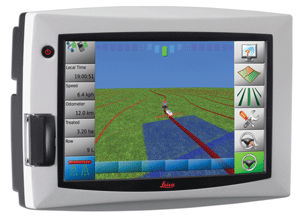 Leica Geosystems is represented here at Commodity Classic by Harlan Little, North American Business Manager. He showed me information that has just been released about their new mojo3D which puts mapping and guidance in a “new perspective.”
Leica Geosystems is represented here at Commodity Classic by Harlan Little, North American Business Manager. He showed me information that has just been released about their new mojo3D which puts mapping and guidance in a “new perspective.”
Designed to help growers get the job done more quickly and efficiently, the system combines a unique, three-dimensional user interface with rugged, water-resistant metal hardware built to withstand tough rural conditions.
With a large 7” touch-screen display and high-quality three-dimensional graphics, the Leica mojo3D has been built for ease of use. It has an intuitive, icon-based menu structure and setup wizards to minimize the time it takes to set the controls and get on with the task at hand. Users can change settings quickly and easily by tapping the relevant icon, without having to navigate away from the main guidance screen.
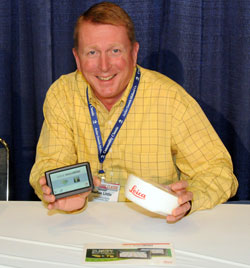 Users can customize the Leica mojo3D to meet individual requirements, with a range of option packs available, including terrain-compensated electric auto-steer via the Leica QuickSteer motor and Leica TWIST terrain compensation unit. Single section or multi-section control to reduce overlap and misses in spraying, spreading and planting applications is also available. Additionally, users have the option to upgrade auto-steer accuracy to 2cm RTK positioning with the Leica mojoRTK.
Users can customize the Leica mojo3D to meet individual requirements, with a range of option packs available, including terrain-compensated electric auto-steer via the Leica QuickSteer motor and Leica TWIST terrain compensation unit. Single section or multi-section control to reduce overlap and misses in spraying, spreading and planting applications is also available. Additionally, users have the option to upgrade auto-steer accuracy to 2cm RTK positioning with the Leica mojoRTK.
The Leica mojo3D may be pre-ordered now, and will begin shipping March 29. For more information about the Leica mojo3D and other ag guidance solutions from Leica Geosystems visit www.AgGuidance.com.
I interviewed Harlan and you can learn all about the new features and benefits of the new mojo3D in our discussion. He also talks about the mojoMINI which he’s holding in his hands in the photo.
You can listen to my interview with Harlan below.
Commodity Classic Photo Album
AgWired coverage of the 2010 Commodity Classic
is sponsored by:  and
and 




 and
and 
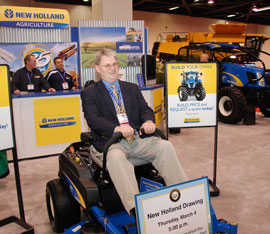 Hopefully, Scott Richert’s wife believes him by now. He really did win the
Hopefully, Scott Richert’s wife believes him by now. He really did win the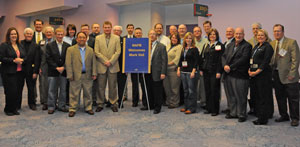 Members of the
Members of the 

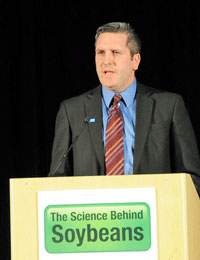 “The soybean market has great potential for growth but yields haven’t increased that much in the last few years so what we really see is an opportunity is to get more from every acre by using some different practices and new technologies such as the new Kixor herbicide technology that BASF has,” said Paul Rea, Director of BASF US Crop Protection Division.
“The soybean market has great potential for growth but yields haven’t increased that much in the last few years so what we really see is an opportunity is to get more from every acre by using some different practices and new technologies such as the new Kixor herbicide technology that BASF has,” said Paul Rea, Director of BASF US Crop Protection Division.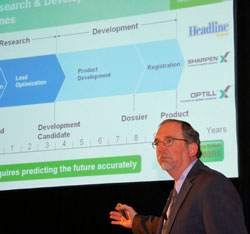 BASF Technical Service Manager Rick Chamblee says Kixor, which is the active ingredient in a number of new products that were just approved for use in this country last fall, is a great example of how BASF looked ahead to anticipate grower needs in the future. “When we started working on the Kixor family of products 9-10 years ago, glyphosate tolerant weeds were not even on the horizon,” Rick said. In fact, only one weed was resistant in the United States, today there are six broadleaf weeds that are tolerant to glyphosate that are commonly found in soybean production.
BASF Technical Service Manager Rick Chamblee says Kixor, which is the active ingredient in a number of new products that were just approved for use in this country last fall, is a great example of how BASF looked ahead to anticipate grower needs in the future. “When we started working on the Kixor family of products 9-10 years ago, glyphosate tolerant weeds were not even on the horizon,” Rick said. In fact, only one weed was resistant in the United States, today there are six broadleaf weeds that are tolerant to glyphosate that are commonly found in soybean production.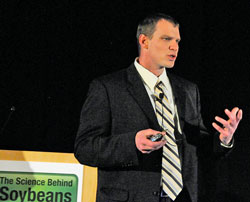 The average soybean yield in Illinois has been 45-46 bushels per acre the last two years, which Vince says has been pretty consistent for the past five years and growers would really like to see that improve by at least two bushels per acre. They would really like to see yields as high as the 100 bushels per acre that Kip Cullers sees on his farm, so Vince took a closer look at what Kip does last year to bring back to Illinois. “There’s a lot we have left to learn on how to maximize each individual plants’ productivity in soybean and really approach some of the levels of individual plant management like we’ve been doing in corn,” said Vince. He stresses the importance of early weed control as something growers can do to help improve yields. “Controlling weeds, starting with a clean field and making sure you don’t lose bushels to weeds early in the season is very important,” Vince said.
The average soybean yield in Illinois has been 45-46 bushels per acre the last two years, which Vince says has been pretty consistent for the past five years and growers would really like to see that improve by at least two bushels per acre. They would really like to see yields as high as the 100 bushels per acre that Kip Cullers sees on his farm, so Vince took a closer look at what Kip does last year to bring back to Illinois. “There’s a lot we have left to learn on how to maximize each individual plants’ productivity in soybean and really approach some of the levels of individual plant management like we’ve been doing in corn,” said Vince. He stresses the importance of early weed control as something growers can do to help improve yields. “Controlling weeds, starting with a clean field and making sure you don’t lose bushels to weeds early in the season is very important,” Vince said. 
 Users can customize the Leica mojo3D to meet individual requirements, with a range of option packs available, including terrain-compensated electric auto-steer via the Leica QuickSteer motor and Leica TWIST terrain compensation unit. Single section or multi-section control to reduce overlap and misses in spraying, spreading and planting applications is also available. Additionally, users have the option to upgrade auto-steer accuracy to 2cm RTK positioning with the Leica mojoRTK.
Users can customize the Leica mojo3D to meet individual requirements, with a range of option packs available, including terrain-compensated electric auto-steer via the Leica QuickSteer motor and Leica TWIST terrain compensation unit. Single section or multi-section control to reduce overlap and misses in spraying, spreading and planting applications is also available. Additionally, users have the option to upgrade auto-steer accuracy to 2cm RTK positioning with the Leica mojoRTK. 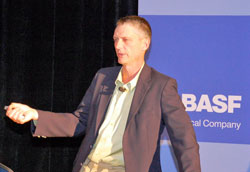 You can never get enough of the always entertaining World Soybean Yield Champion Kip Cullers.
You can never get enough of the always entertaining World Soybean Yield Champion Kip Cullers.